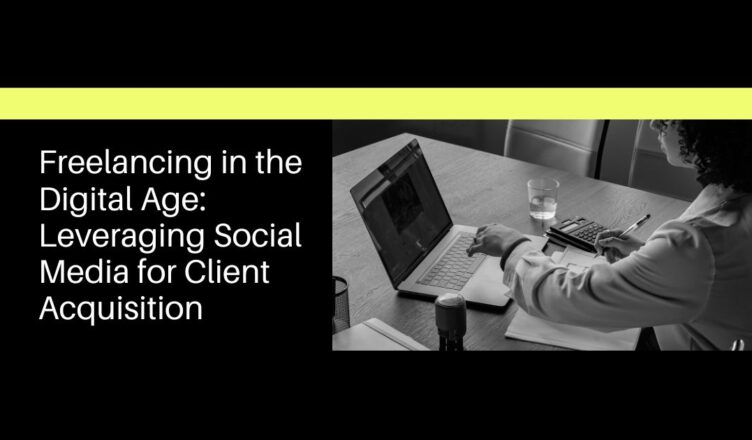Introduction
One of the biggest shifts in the rapidly evolving workplace is the rise of freelancing in recent years. Web developers, graphic designers, and other sorts of writers all have a variety of alternatives thanks to the digital world. However, with increased competition, it’s imperative to stay one step ahead. This blog post will look at how social media may be used to grow your clientele and flourish as a freelancer.
Social Media Strategies for Freelancers: Supercharge Your Client Acquisition
Effectively utilizing social media might be the difference between having trouble finding clients and seeing steady growth in your freelancing business. So, let’s look at key tactics for boosting your social media client acquisition:
1] Build a Strong Personal Brand
In the digital age, your brand is your calling card. It helps potential customers trust you and distinguishes you from the competition. A tremendous forum for showcasing your abilities, knowledge, and personality is provided by social networking sites like LinkedIn, Twitter, and Instagram.
Start by optimizing your social media profiles. Use professional photos and write compelling bios highlighting your freelancing niche and skills. Consistency is key, so ensure your brand identity is reflected in your profile pictures, cover photos, and content.
2] Choose the Right Platforms
Not all social media platforms are created equal, and not every platform suits every freelancer. The key is identifying where your potential clients hang out and focusing your efforts there.
For B2B freelancers, LinkedIn is often the go-to platform. It’s a hub for professionals and offers various tools for networking and showcasing your expertise. On the other hand, if you’re in a visually appealing industry like design or photography, Instagram and Pinterest can be more effective.
3] Valuable Content
Once you’ve chosen your primary platforms, it’s time to start sharing valuable content. Content marketing is a potent strategy for attracting clients. Create informative blog posts, videos, infographics, or any other content that demonstrates your knowledge and skills.
Remember, consistency is essential. Regularly update your social media profiles with fresh, relevant content. Engage with your audience by responding to comments and messages promptly.
4] Network and Connect
Social media is not just about broadcasting; it’s also about engaging and building relationships. Actively network with potential clients, fellow freelancers, and industry professionals. Join relevant groups and communities to participate in discussions and share your insights.
Don’t be afraid to reach out to potential clients directly. Send personalized messages highlighting how your freelancing services can solve their problems or meet their needs.
5] Show Your Work
Demonstrating your work is essential in freelancing since a picture speaks a thousand words. Share your portfolio on social media and keep it updated with your most recent work. Visual proof of your skills and capabilities can be incredibly persuasive.
Use platforms like Behance, Dribbble, or GitHub to showcase your work extensively. Share links to these profiles on your social media channels to direct potential clients to your best work.
6] Collect and Showcase Testimonials
Client testimonials are powerful social proof. If you’ve had satisfied clients, ask them for testimonials or reviews. Share these on your social media profiles to build trust with potential clients.
Additionally, you can create visually appealing graphics with client testimonials and share them as part of your content strategy. Testimonials provide concrete evidence of your skills and reliability.
7] Paid Advertising
While organic growth is important, you can expand your audience by using paid social media advertising. You may contact potential customers based on their demographics, hobbies, and habits via platforms like Facebook and Instagram, which provide personalized advertising alternatives.
Investing in paid advertising can be a cost-effective way to promote your freelancing services and acquire new clients.
8] Engage with Trends and Hashtags
Stay updated on market developments and trending hashtags pertinent to your freelancing area. Engaging with popular subjects will increase the likelihood that more people will see your material. Make smart use of these hashtags and trends to broaden your reach and engage with potential customers.
Conclusion
In the digital age, there are countless opportunities for freelancers who are prepared to adapt and use social media to get clients. Remember that success on social media calls for endurance and patience. Maintain your composure and tweak your plan as you determine what works best for your freelancing business. Social networking has the potential to be an important client acquisition strategy for freelancers in the digital era if used strategically and with commitment. Join ZoopUp today and unlock endless freelance opportunities! Sign up now to showcase your skills and connect with clients.
FAQs
Is spending money on sponsored social media advertising worthwhile to attract customers?
For freelancers, social media paid advertising may be an effective investment. It enables you to reach potential customers more effectively, enhance your exposure, and target particular populations. Before utilizing sponsored advertisements, it is necessary to have a crystal-clear strategy and budget in place.
How can freelancers effectively network on social media?
Engaging with peers in the business and potential clients is necessary for effective networking on social media. Participate in debates, join groups and communities pertinent to you, and make an effort to make connections. The secret to effective networking is developing sincere relationships.
Which social media platforms are most effective for freelancers?
Depending on your specialization, social media platforms’ usefulness might change. However, freelancers frequently utilize websites like Facebook, Twitter, Instagram, and LinkedIn. The platform you choose should be compatible with both your target market and the kind of content you produce.

